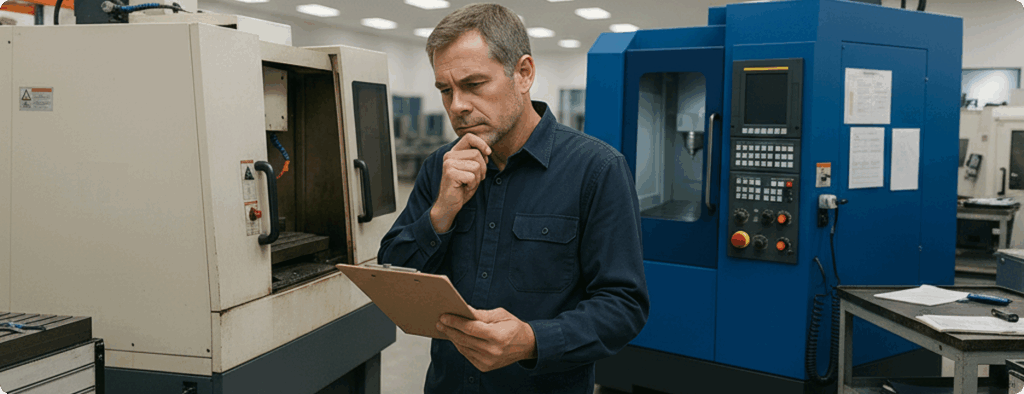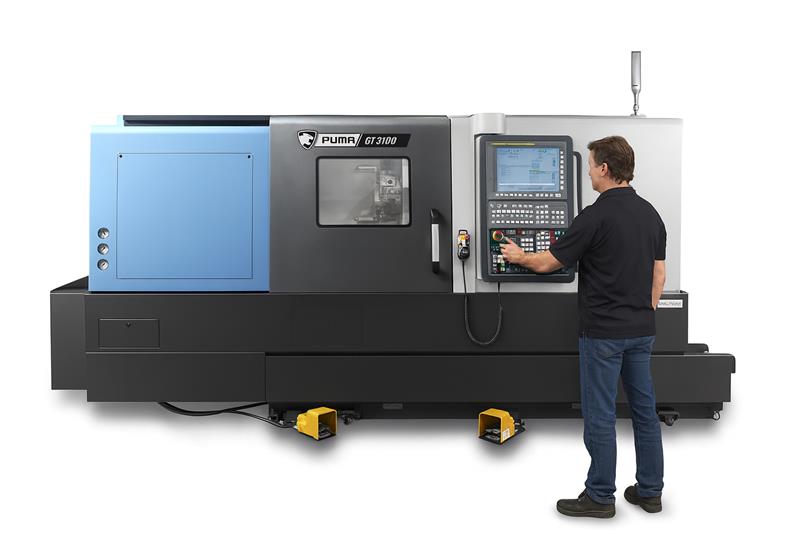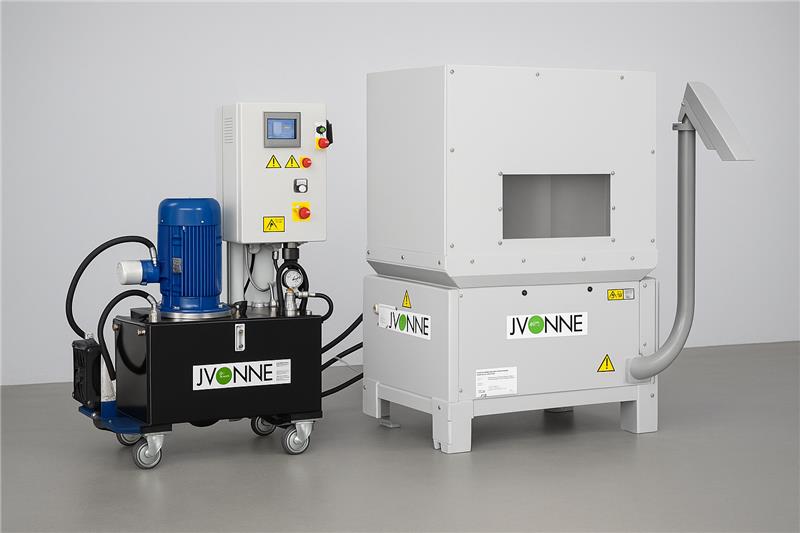The Crossroads Every Shop Faces
In the fast‑paced world of CNC machining, unexpected breakdowns, declining precision, or stagnant throughput force manufacturers and metalworking shops to a critical decision: is it time to service your existing machine, or should you invest in new equipment? With interest rates, production pressures, and global competition on the rise, knowing how to weigh the pros and cons is essential. At Ferro Technique, we’ve helped Eastern Canada’s shops make these choices for over seven decades Ferro Technique. In this expert guide, we break down the analytical framework to help you decide with confidence.
Why the Decision Matters
Choosing incorrectly can be costly:
- Downtime: Waiting for repairs or new delivery can disrupt production.
- Cost: Service may seem cheaper initially, but repeated fixes add up.
- Performance: Legacy machines can’t always meet modern precision or cycle‑time demands.
- Operator efficiency & training: New machines often include updated controls and safety systems that require training but can raise productivity.
At Ferro Technique, we know downtime is expensive, that’s why our service team offers same‑day or next‑day technician response across Ontario, Quebec, and the Maritimes through our Mississauga, Windsor, and Montreal branches Ferro Technique.
Step 1: Diagnose the Machine’s Condition
Before deciding to repair or replace, conduct a thorough assessment:
- Age & usage: How many hours? What kind of cycles? Breakpoints often appear after 8–10 years of heavy use.
- Service history: Was preventative maintenance followed consistently? Ferro’s preventive programs cover inspections, calibrations, part replacements, and predictive diagnostics Ferro Technique.
- Current performance issues: Is accuracy slipping? Are spindle vibrations, misalignment, or error codes recurring?
- Repair cost estimate: Obtain an itemized quote for parts, labour, and calibration.
- Availability of spare parts: OEM-certified parts may be hard to source for older models.
Include operator input, do they feel bearings or shaking? Are cut tolerances drifting? A properly trained operator often spots early signs before failure Ferro Technique.
Step 2: Estimate the True Cost of Ownership
Compare two scenarios side by side:
Scenario A: Service & Repair
- Immediate cost: Parts, labour, calibration, adjustments.
- Recurring risk: Likelihood of repeat breakdowns if machine is near end-of-life.
- Operational impact: Lost production during repair windows.
- Opportunity cost: Slower cycles, lower precision, higher scrap.
Often, repairing a legacy machine feels cheaper, but aging components may require ongoing servicing, eroding cost advantages.
Scenario B: Invest in a New Machine
- Upfront cost: List price, installation, possible customization.
- Included value: Training, warranty, operator familiarization, OEM support, modern safety systems, tooling packages.
- Efficiency gains: Higher speeds, multi‑axis capability (e.g., DN Solutions DVF or SMX series), automation, lower scrap rates.
- Reduced downtime risk: Less reactive maintenance, longer lifecycle.
- Resale value: Newer machine equipment tends to retain higher value and can be upgraded or traded.
As noted in industry analyses, new machines often include training, calibration packages, and modern controls, features that used equipment and service don’t always deliver, increasing long‑term value.
Step 3: Key Factors to Weigh
Break your decision into practical criteria:
A. Scale and Volume of Production
- High‑volume shops: Downtime has compounding costs, servicing may not be strategic risk management.
- Lower‑volume or seasonal operations: Service may suffice if uptime is reasonably steady.
B. Complexity of Parts / Tolerance Needs
- Tight tolerances or multi‑axis parts: Older machines may struggle. New multi‑tasking models (like DVF or SMX) deliver precision from the start Ferro Technique.
C. Financial Considerations
- Budget constraints: Service requires less upfront capital.
- Financing or leasing options: Ferro Technique offers flexible financing to help spread the cost of new machines and includes training and service support to maximize ROI Ferro Technique.
D. Warranty & Manufacturer Support
- Existing OEM warranty: Repairs under warranty may be nearly free. Beyond warranty, parts can be costly for outdated controls.
- Service support longevity: Ferro’s factory‑certified experts service DN Solutions, Brother, Hartford, Muratec, and more, even older inventory, with rapid response.
E. Safety, Energy Efficiency & Features
- Newer machines meet current safety standards, often include integrated guards, energy‑efficient drives, and modern CNC controls, driving operator safety and lower utility costs.
6. Decision Matrix: When to Service vs. Replace
| Condition/Observation | Likely Decision |
|---|---|
| Machine < 5 years old, strong history of PM | Services |
| Machine > 8–10 years, frequent breakdowns or worn parts |
Replace |
| Production needing higher precision or multi‑axis parts | Replace |
| Budget tight and short‑term need | Service |
| High downtime costs, tight volume constraint | Replace |
| Suitable OEM support and warranty in place | Service (especially if covered) |
| Safety systems outdated, energy costs high | Replace |
7. Service Packages from Ferro Technique: What’s Included
If your evaluation leans toward service, Ferro Technique offers flexible programs:
- Preventative Maintenance (PM): Scheduling tailored inspections, laser alignment, spindle checks, calibration, cleaning routines, and critical parts replacement to prevent failures.
- Predictive Maintenance: IoT‑enabled sensors to monitor vibration, temperature or performance drift before downtime happens Ferro Technique.
- OEM Parts Inventory: Extensive parts stock across brands ensures faster turnaround.
- Same- or Next‑Day Service: With over 35 technicians across Eastern Canada, Ferro guarantees rapid response times to get you back up quickly.
- Training & Calibration: Included or available to ensure operators are maximizing performance safely.
8. Upgrading Smartly: When New Makes Sense
If you decide to replace your machine, here’s what Ferro Technique offers:
- Rapid delivery: Many DN Solutions, Brother, Hartford & Muratec models are available within 2–3 weeks, minimizing lead time relative to most OEM backlogs.
- Flexible machine options:
- High‑precision 5‑axis centers: DVF 5000/6500/8000
- Multi‑tasking turning/milling: PUMA SMX Series
- Advanced automation: Muratec twin‑spindle cells
- Turnkey solutions: Complete installations including automation design, accessories, and tooling kits as needed.
- Training programs: From formal sessions to lunch‑and‑learns, Ferro trains your team to program, probe, and operate efficiently.
9. Steps to Take Right Now
- Schedule a machine health audit, Ferro’s technicians can assess your equipment and recommend service vs. replacement.
- Obtain detailed cost estimates for needed repairs versus new machine investment including delivery, installation, training, parts, and warranties.
- Map your business needs over the next 1–3 years, production targets, part complexity, workforce changes.
- Consider total cost of ownership, including downtime, scrap, productivity, energy use, and operator training.
- Work with your Ferro sales and service team, they can tailor service packages and help with financing or leasing to fit the budget.
10. Final Thoughts: Balancing Strategy with Reality
There’s no one-size-fits-all answer. For some, servicing a machine extends lifecycle with minimal cost. For others, outdated tech limits growth, and replacement becomes an investment in future competitiveness. At Ferro Technique, we believe:
- Preventative service is powerful—when properly executed, it staves off unplanned downtime Ferro Technique.
- Upgrading to modern multi‑tasking or automation opens new capacity—thanks to flexible shapes, fewer setups, higher accuracy, and IoT monitoring.
- Support infrastructure matters—with more certified technicians and parts inventory, you minimize wait time and risk Ferro Technique.
Whatever path you choose, make the decision informed, actionable, and aligned to your long‑term goals.




